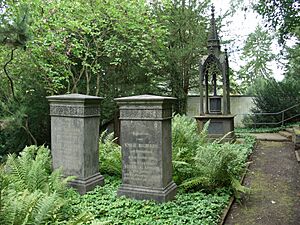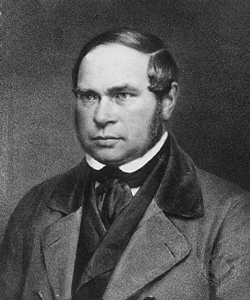Karl Baedeker facts for kids

Karl Ludwig Johannes Baedeker (pronounced BAY-dik-er; born Bädeker; 3 November 1801 – 4 October 1859) was a German publisher. His company, Baedeker, created the most popular and trusted guidebooks for travelers.
Karl Baedeker came from a long line of printers, booksellers, and publishers. He was the oldest of ten children. His father, Gottschalk Diederich Bädeker, had taken over the family publishing business. This company also printed the local newspaper, the Essendische Zeitung. Everyone expected Karl to join the family business too.
Around 1850, Karl changed the spelling of his family name. He changed it from Bädeker (with the umlaut, which is like two dots over the 'a') to Baedeker.
Contents
Karl Baedeker's Life Story
Karl Baedeker was born in Essen, a town in what was then the Kingdom of Prussia. His birthday was November 3, 1801.
After finishing school in Hagen, he left home in 1817. He went to study humanities in Heidelberg. There, he also worked for a while at a big local bookstore. After serving in the military, he moved to Berlin. From 1823 to 1825, he worked as an assistant at Georg Andreas Reimer, another important bookseller.
He then returned home to Essen and worked with his father until 1827. That year, he moved to Coblence (now called Koblenz) to start his own bookselling and publishing company. Essen was a small town then. Karl felt that Koblenz was a better choice. It was larger, the capital of the Prussian province of the Rhine, and a popular place for tourists.
How the Guidebooks Started
In 1832, Baedeker's company bought another publishing house in Koblenz. This company had published a travel guide in 1828. It was called Rheinreise von Mainz bis Cöln; ein Handbuch für Schnellreisende (A Rhine Journey from Mainz to Cologne; a Handbook for Travellers on the Move). This book gave Baedeker the idea for his own travel guides.
When the original author died, Baedeker decided to publish a new edition. He used some of the old material but added many of his own ideas. He wanted his travel guides to give travelers all the information they needed. This included details about routes, transportation, places to stay, restaurants, and sights. He even included prices and tips! His goal was to help travelers explore without needing any other information.
Travel guides were not new at the time. Baedeker was inspired by the English guide books published by John Murray. However, Baedeker's guides were special. They included very detailed information on routes, travel, and places to stay. This was a new and helpful idea.
Baedeker always gave credit to John Murray III. He learned a lot from Murray's ideas about how travel guides should be. As a bookseller in Koblenz, Baedeker often saw tourists looking for Murray guides. At that time, John Murray III was the leader in travel guides. But Baedeker was about to change that. Many people now call him the 'father of modern tourism'.
The Famous Red Guides
In 1846, Baedeker started using his famous 'star' ratings. He used stars to rate sights, attractions, and places to stay. This idea came from the star system in the Murray guides. He used this in the third edition of his Handbuch für Reisende durch Deutschland und den Oesterreichischen Kaiserstaat. This edition was also his first 'experimental' red guide.
He also decided to call his travel guides 'handbooks', just like John Murray III. Baedeker's first guides had tan (light brown) covers. But from 1856 onwards, he started using Murray's red covers with gold lettering. These red covers became the well-known sign of all Baedeker guides. The guides became famous for being clear, detailed, and very accurate.
Baedeker's Travel Guides
Here are some of the important travel guides published by Karl Baedeker:
- 1828: Rheinreise von Mainz bis Cöln; Ein Handbuch für Schnellreisende
* This was the travel guide Baedeker got when he bought the Röhling company. He reissued it in 1832. In 1839, he published a completely new version. Many people think this 1839 guide was the first true Baedeker. It set the high standards for all his future guides.
- 1844: Schweiz (Switzerland)
* This guide was almost a direct translation of John Murray III's 1838 "Handbook for Travellers in Switzerland." However, it became one of Baedeker's most important works. It was a turning point in his career. This guide was very popular. It had 39 updated editions until 1937. Its French version, La Suisse, appeared in 1852. The English version, (Switzerland), came out in 1863, after Baedeker had passed away. Karl Baedeker himself only published guides in German and French.
- 1855: Paris und Umgebung (Paris and Surroundings)
* This guide about Paris also became very popular.
Maps in the Guides
From the very beginning, Baedeker knew how important good maps were. He wanted his travel guides to have high-quality, reliable maps. At first, the maps were black and white. He hired Eduard Wagner, a map expert from Darmstadt. The maps Wagner made for Baedeker were very advanced for their time.
Conversation Manuals
The first Baedeker travel guide in English came out in 1861, after Karl Baedeker had died. However, in 1836, he published The Traveller's Manual of Conversations. This book was in English, German, French, and Italian. It also included many useful Dutch phrases and words.
This manual was a huge success and had many editions. It was especially popular with tourists traveling through Koblenz on their way to Switzerland. Karl Baedeker wrote in the preface that he was "always ready to afford any information to those travellers, who do him the honour to visit his establishment."
The manual helped travelers be more independent. It meant they didn't always need to hire expensive local guides. The book's goal was to make travel easier and more comfortable. It also included helpful information about money exchange rates and different coins used across Europe. This was another new idea from Baedeker.
Amazing Stories About Karl Baedeker
Stories about Karl Baedeker show what kind of person he was. He was known for working very hard and carefully. He had high standards for himself and his work. He was also known for being completely honest.
Baedeker often did his research secretly. He would travel without letting people know who he was. This way, he could see how places really treated regular tourists.
The Hotel Story
Here's a famous story from Michael Wild, a Baedeker historian:
"Karl Baedeker once stopped at a hotel in Vevey, Switzerland, in 1852. He looked like a simple tourist, with a plain coat and a travel bag. He asked for a nice room with a view of the lake. But the hotel staff showed him a small, stuffy room in the roof, overlooking the inner courtyard. The porter rudely told him nothing else was available.
Service at supper was slow. But the landlord quickly pushed the Visitor's Book in front of Baedeker and told him to sign it. Quietly, the stranger took his pen and wrote, "Baedeker, Karl, bookseller from Coblence." The landlord's face turned pale. This was worse than not recognizing a lord or a prince!
Baedeker then told the landlord all the problems with his hotel. The landlord tried to explain that it was a busy season. But Baedeker took away the hotel's prized star rating. He said, "a renowned hotel must take extra pains." The landlord begged, but it was no use. In the next edition of the "Schweiz" guide, the star was gone. However, Baedeker was fair. He gave the star back later, but only after he was sure the hotel was meeting his high standards again."
The Milan Cathedral Story
Another famous story is about the Milan Cathedral. This story was shared by Herbert Warren Wind in The New Yorker magazine:
"In 1844, a scholar named Gisbert von Vincke was climbing the stairs to the roof of the Milan Cathedral. He noticed a man in front of him. This man was about five feet seven inches tall, with broad features. Every so often, he would reach into his vest pocket, pull out a small object, and put it into his pants pocket.
Later, von Vincke saw the man in his hotel dining room. The headwaiter told him it was Baedeker. After the meal, von Vincke introduced himself and asked about the strange ritual on the cathedral stairs. Baedeker happily explained that he was counting the steps to the roof. To make sure he didn't lose count, he had filled one pocket with peas. After every twenty steps, he moved a pea from that pocket to another pocket."
When he came down from the roof, Baedeker moved the peas back. This way, he could be sure his count was correct. The number of peas, multiplied by 20, plus any remaining steps, gave him the exact number.
Karl Baedeker's Legacy
Towards the end of his life, Baedeker wondered if his work would last. He didn't know that his name, Baedeker, would become a common word for any travel guide. He also didn't know that his company, Verlag Karl Baedeker, would become the most successful travel guide publisher in the world.
Karl Baedeker passed away in Koblenz on October 4, 1859. He was only 57 years old. Herbert Warren Wind wrote in The New Yorker that Baedeker had tried to do the work of many people. He prepared new guidebooks and updated old ones all by himself. This hard work eventually wore him out.
Michael Wild, the historian, once wrote: "It is a moot point whether he invented tourism or tourism invented him." This means it's hard to say if Baedeker created modern tourism, or if the growing interest in travel led to him creating his guides.
Baedeker is buried at the main cemetery (Hauptfriedhof) in Koblenz.
See also
- Baedeker
- List of Baedeker Guides


